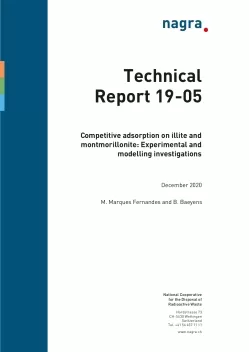
Technical Report NTB 19-05
Competitive adsorption on illite and montmorillonite: Experimental and modelling investigations
Besides the radioactive elements, stable elements are an integral and non-negligible part of the nuclide vector of a realistic deep geological repository for radioactive waste. Sources for the stable elements include amongst others: corrosion of the canisters, dissolution of the spent fuel and vitrified high-level waste, tunnel backfill materials, porewater and the host rock itself. Their presence could affect the radionuclide retention in the near- and far-fields of the argillaceous barriers since the stable elements and the released radionuclides might compete with one another for the available sorption sites, and thus reduce their uptake on them. Quantifying the influence of competitive adsorption on the transport of released radionuclides through the multi-barrier system in a deep geological repository is undoubtedly important.
An experimental programme was dedicated to the influence of competitive adsorption between relevant nuclides, comprising inter- and intra-valences, on 2:1 clay minerals, namely montmorillonite and illite, which are the major components of bentonite and the argillaceous host rock Opalinus Clay, respectively. The present report summarises the experimental and modelling outcome involving the elements NiII, ZnII, CoII, FeII, PbII, EuIII, AmIII, ThIV, NpV and UVI. Competitive adsorption experiments were performed considering binary metal systems as well as some multi-element systems. Generally, the adsorption of a trace element on the clay minerals was quantified as a function of increasing competing metal concentration.
The experimental observations on the competitive adsorption behaviour of the elements investigated in this study were quantified using the 2 site protolysis non-electrostatic surface complexation and cation exchange (2SPNE SC/CE) model. Depending on the element combination three different cases, i.e., competitive, non-competitive and partially competitive adsorption behaviour, were observed on both illite and montmorillonite.
The metals with the same valence state (ZnII, CoII, NiII and FeII) or (EuIII and AmIII) do compete. In such a case, the 2SPNE SC/CE model can be applied without any modification. The competitive elements are allowed to sorb on the same set of strong, weak and planar sites and the resulting effect on their adsorption behaviour depends on the concentration and binding strengths (i.e., surface complexation constants) of the elements under consideration.
Binary experiments with elements with different valence states provided evidence for non-competitive adsorption behaviour for the combinations NiII/ZnII, EuIII, ThIV, NpV or UVI. The unaffected sorption of the trace element can only be modelled under the assumption that each element has its own strong sites, implying that in a multi-element adsorption modelling additional element specific sets of strong sites need to be introduced.
Partially competitive behaviour was identified when the adsorption of trace NiII or CoII was measured as a function of increasing PbII or EuIII concentrations. The modelling of these adsorption data with the 2SPNE SC/CE model was only possible by considering additional strong sub-sites with a very low capacity. This approach suggests that within the strong sites defined in the 2SPNE SC/CE model there are metal specific sub-sites “with different affinities and capacities”. Furthermore, its competitive behaviour differs regarding the competing element. This modelling approach can only be applied for binary systems where experimental evidence is available and for which nuclide specific parameters have been derived as shown in this report.
The consequences of competitive adsorption for the radionuclide sorption databases used in the safety analysis can be summarised as follows. In the case that sorption is competitive the concentration of the stable elements in the porewater needs to be considered in the derivation of the Kd values. For the nuclides which are non-competitive, such an approach is not necessary. When the sorption of radionuclides is only partially competitive, the derivation of Kd values can only be carried out when specific parameters have been determined. A conservative approach for the safety analysis for this case would be to assume that adsorption is competitive.
Shop
| hard copy, English | CHF 20,00 |

